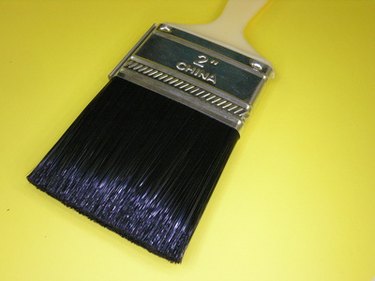
Dowels are used in construction, art and craft projects. These wooden rods come in many lengths and diameters. You must often stain or paint dowels -- especially if you plan to use them in a visible location. Simply grabbing a dowel and slapping on some paint is the fastest way to do a bad job. Instead, use proper preparation and care to produce quality results.
Sanding and Repair
Video of the Day
Begin with the proper prep work on the dowel before you pick up a brush for the first time. Examine the dowel for any cracks, dents or holes; fill these in with wood putty, or simply replace the dowel if the defects are severe. Sand the dowel to prepare it to receive color. Begin with 150-grit sandpaper to even out the surface, then switch to 250-grit to smooth the sanding marks you have created.
Video of the Day
Hanging the Dowel
If you want to apply an even finish to a dowel, you face a nearly impossible task if you must hold one end as you paint and then proceed to paint that area once the previous layer has dried. To solve this problem, screw a 3-inch wood screw just enough into each end of the dowel to grab the wood. You can then hang the dowel horizontally between two boxes and give yourself access to the entire surface. For especially thin dowels, use pushpins in place of screws.
Conditioning
Softer woods such as pine have uneven pores, resulting in stain and paint looking mottled because it soaks deeper into some parts of the wood than others. Applying a wood conditioner closes the pores, allowing a much more even finish. Apply wood conditioner to all woods to play it safe. It won't help hardwoods, but it won't hurt them either. Let the conditioner sit on the wood for 15 minutes, then wipe off any excess with a rag.
Avoiding Brushstrokes
Cheaper brushes can leave brushstrokes on the colored surface of a dowel. Invest in a good paintbrush with synthetic bristles. Natural bristles will soak up stain and some paints, using more materials and costing more money. Spraying paint or stain is an option that naturally leaves no brushstrokes because you aren't using a brush. If you use this method, open windows to ensure proper ventilation, and wear a respirator to protect your lungs.
Drying Paint
Paint's tendency to create a coat on the surface of the dowel makes it much more prone to leaving drip marks than stain. Ignoring the dowel after applying a heavy coat of paint can cause a line of drip bumps to form along the bottom side. Prevent paint from beading along the bottom by applying paint in several thin coats instead of a single thick one and rotating the dowel a quarter turn every few minutes as it dries.